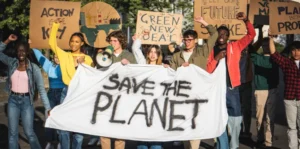Climate News: It Is Grim, But It Isn’t All Bad
January 15, 2025

It seems that every day we confront more dire news about climate change and global warming. Besides the immediate devastations of extreme floods, heat waves, wildfires, and storms we now know that we are going to blow past the 1.50 C warming limit that scientists say portends more dire climate-related disasters. Glaciers continue to melt, and deforestation seems to proceed nearly unabated. A president-elect pledges to take the U.S. out of the Paris Accords, the legally binding international treaty to reduce greenhouse gas emissions that was signed in 2015.
It is very important, then, that we recognize that there are many things that are headed in the right direction toward mitigating the effects of climate change and even perhaps one day reversing it. Let’s start with the results of legislation passed during the Biden administration that address climate change. These new laws include the Infrastructure Investment and Jobs Act, the Inflation Reduction Act, and the American Rescue Plan Act (ARPA). According to a Brookings report, through March 24 “large local governments…have committed over $12.4 billion” of funds from ARPA toward “various types of infrastructure improvements, climate resiliency initiatives, and economic development programs.” Nearly $240 million of those funds are going to “investments in environmentally sustainable and eco-friendly infrastructure.” Last July, the Environmental Protection Agency (EPA) announced it had awarded $4.3 billion in Climate Pollution Reduction Grants.
One interesting aspect of this federal funding for clean energy and electric vehicle (EV) projects is that a majority of it is being spent in Republican Congressional districts and red states. Even though no Republicans voted in favor of the Inflation Reduction Act, the fact that so much money is flowing into their districts suggests that an incoming administration may have trouble reversing the Inflation Reduction Act’s climate project funding stream. We see the possibility that billions of dollars of federal money will therefore continue to flow to promote sustainable energy projects throughout the U.S.
A Mixed International Picture
On an international level, there has been much hand-wringing about the outcome of the annual United Nations-sponsored international climate conference, called COP29, which was held this year in Baku, Azerbaijan. At the November conference it was agreed that wealthy nations will contribute $300 billion by 2035 to help developing countries transition away from fossil fuels and deal with the effects of past and future climate disasters. Here we have a clear “glass half-full, glass half-empty” situation: the amount is far less than the approximately $1.3 trillion experts estimate will be needed to fully help countries that have contributed very little to global warming but face the most damage from climate change. Yet it is still a major advance over the $100 billion pledged in previous conferences. Furthermore, some wealthy countries are stepping up their climate activities in anticipation of the U.S. reneging on its commitments after the new administration takes office in January.
Promising Technological Advances
We can also look toward technological advances that will help us meet climate challenges. For example, there is a pressing need to develop batteries with greater storage capacity to handle the vagaries of wind and solar energy. After all, the wind doesn’t always blow nor the sun shine. Utilities that use fossil fuels to create electricity have tanks of gas and oil on hand to meet energy demands, but storage of energy derived from wind and solar sources is more complicated. Right now, wind and solar energy account for about 15 percent of electricity globally, and this will undoubtedly increase as sustainable energy continues to prove cost effective compared to energy derived from fossil fuels. Fortunately, new storage battery technologies are emerging. For example, the Hokkaido Electric Power Plant in Japan is using a new kind of battery, called a flow battery, that can store vast amounts of energy generated by wind and solar sources. Although there are technical and financial challenges to building flow battery farms, research and market forces (see below) will continue to advance battery technology. We need to be sure that wealthy nations continue to fund battery research so that the transition away from fossil fuels can be made without sacrificing energy needs.
Another area of technological innovation that bears watching is carbon capture. Efforts to remove carbon from the atmosphere are controversial. It is unclear that carbon removal technologies will work and there are safety concerns. Furthermore, some experts believe that carbon removal discussions will give people a false sense of security, offering the myth that we can continue to release massive amounts of carbon dioxide into the atmosphere and worry about removing it later. Still, projects to remove carbon are proliferating globally. In New York City, where Critica is based, for instance, a start-up company called Vycarb is adding crushed rocks and other chemicals to the East River to remove carbon dioxide. Efforts like this are already underway in many places around the world. It remains to be seen whether carbon capture will prove a viable means of reducing the atmospheric carbon burden.
Perhaps the most intriguing technology to combat climate change is nuclear fusion. Current nuclear energy relies on fission—splitting atoms to release energy. This releases no greenhouse gases but does generate nuclear waste that has worried many. Fusion, on the other hand, involves forcing hydrogen atoms to fuse into helium atoms, releasing almost unimaginable amounts of energy. To be clear, nuclear fusion is a long shot. So far, it has not been possible to create nuclear fusion reactions that release significantly more energy than are needed to trigger the reaction in the first place. Yet harnessing the method used by the sun to create energy would create a vast energy source that releases no greenhouse gases and does not generate significant amounts of nuclear waste. Right now, there are many government and private efforts underway to develop commercially viable nuclear fusion energy. In 2022, scientists at the Lawrence Livermore National Laboratory in California announced they had briefly created a fusion reaction that created more energy than was put in to create the reaction. Now, involved companies insist they will be able to make fusion machines that generate more energy than they consume in just a few years. We remain skeptical that such a timeframe is realistic, but it is intriguing to imagine a future in which safe, efficient nuclear fusion produces all the energy we need without warming the earth.
Will Public Outcry Influence Policy?
Alexander E. Gates, Professor of Earth and Environmental Science at Rutgers University, makes a good case that technology and innovation have worked in the past to enable countries to solve climate threats. “They did it with the pesticide DDT, lead paint and the power plant emissions that were causing acid rain, among others,” he wrote. “In each of those cases, growing public outcry eventually led to policy changes, despite pushback from industry.”
The question, of course, is whether we have sufficient “public outcry” about climate change to influence policy change. Although there is often initial opposition to policies that are beneficial to the climate, research shows that once there is experience with these policies voters become more positively inclined. An example is the British Columbia carbon tax that was introduced in 2008. Initial misgivings gave way to popular support over time. This was also true after trial periods of congestion pricing in Stockholm and Gothenburg, Sweden. U.S. Americans are worried about climate change and a majority want the government to prioritize developing renewable energy sources. Although both presidential candidates pledged not to stop fracking for oil and gas, polls show that a majority of Americans oppose more hydraulic fracking. We need to capitalize on public sentiment to push elected officials in the direction of policies that protect the earth.
Market Forces May Prevail
Even without the support of politicians, market forces are pushing in the direction of sustainable energy. Energy generated by solar and wind sources is steadily becoming cheaper. As battery storage options improve, it is going to be increasingly more economical to shift away from burning coal, gas, and oil. Another Brookings report contends that “Transitioning to an electric grid powered by the sun and the wind instead of oil, natural gas, and coal will produce substantial economic benefits especially in rural and manufacturing areas…” the report estimates that transitioning to electricity generated by sustainable sources will ultimately lower wholesale electricity prices between 20% and 80% by 2040. Companies around the world have made impressive commitments to reducing their carbon footprints. The number of companies that have signed onto the Science Based Targets initiative, which commits them to substantially decreasing their release of greenhouse gasses, increased from 164 in 2018 to over 6,000 by November 2024. If corporations decide to lower their carbon emissions, it will be tough for climate change-denying legislators to stand in their way.
It may also be hard to stop the advance of electric vehicles. As reported in the Wall Street Journal, there is a new push by several start-ups to bring electric vehicle charging stations to U.S. cities. “New York City has become a hotbed of EV charging innovation, with three promising startups, each with different approaches,” the report tells us. And here again, new battery technology is paving the way to more EV uptake. A company based in Taiwan—ProLogium—has developed a battery that can charge an EV from 5 to 60 percent in just five minutes. And the battery is actually lighter than current EV batteries. This is important because anxiety about finding reliable charging stations is a major concern for potential EV purchasers. President-elect Trump has indicated he will cancel the $7500 federal tax credit for EVs and roll back greenhouse gas emission standards that favor them over fossil fuel-powered engines. But once again, market force may stymie some of those efforts. Climate reporter Lisa Friedman wrote in the New York Times last November that “The country’s top automakers spent billions to transition to electric vehicles. Now they don’t want the incoming president to eliminate emissions rules. Utilities want to keep subsidies for wind and solar energy.” The prospects for significantly increasing oil and gas production in the U.S. also seem dim to some experts. This is because we are already producing record amounts of crude oil and “Oil and gas companies are buying back stocks and paying dividends to shareholders at a record pace, which they wouldn’t do if they saw better investment opportunities,” writes Columbia University senior research scholar Gautam Jain.
Major changes in the technologies we use depend in large part on what becomes financially viable and practical. The world quickly switched from horse-drawn carriages to automobiles. The first commercial flight took to the air only 11 years after the Wright Brothers flew the first plane at Kitty Hawk. More recently, we ditched rotary phones for cell phones and tossed away typewriters in favor of computer-based word processing at rapid paces. As it becomes cheaper to generate electricity from wind and solar power, startup companies begin making money from EV chargers, and large corporations devote major funding to sustainable energy projects it will be nearly impossible to stop the transition away from fossil fuels. At that point, even climate denying politicians will be forced to bow before market forces.
Right now, it is estimated that the total global investment in climate solutions is more than $1 trillion dollars annually. This huge amount of money is far less than is needed but does illustrate the fact that climate change is being taken seriously in many places around the world, with major financial investments applied. We did get a little bit of good news in October when it was revealed that the earth is now gaining less heat than it has for several years. The march to climate devastation does not seem inevitable.
We do not mean to paint a rosy picture about the prospects of dealing with climate change. There is still widespread denial that global warming is really a problem, people are reluctant to endorse moving away from fossil fuels, and the earth continues to heat up at a frightening pace. Yet, we also see that tremendous amounts of time, effort, and money are now being spent on climate resiliency projects and sustainable energy development. Market forces are driving us in the direction of favoring less expensive energy sources and technological advances are making wind and solar energy more practical. We need to vigorously highlight and advocate for these opportunities.
Related Posts

The Glaciers Are Melting...Very Fast
Posted in climate change
We have been amply warned about climate change. What should we be doing now to make a difference?

Electric Vehicles Are Really Greener Than Gas-Powered Vehicles
Posted in climate change
Given the benefits of electric vehicles, why are many people still opposed to them? We examine some of the psychological reasons why people may resist the use of EVs.